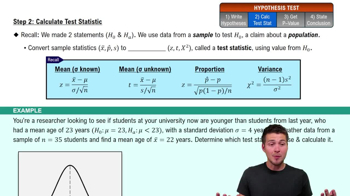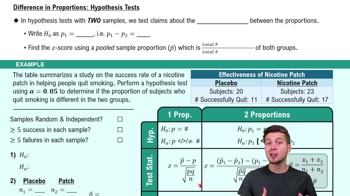Ghosts The following table summarizes results from a Pew Research Center survey in which subjects were asked whether they had seen or been in the presence of a ghost. Use a 0.01 significance level to test the claim that gender is independent of response. Does the conclusion change if the significance level is changed to 0.05?
Table of contents
- 1. Intro to Stats and Collecting Data1h 14m
- 2. Describing Data with Tables and Graphs1h 55m
- 3. Describing Data Numerically2h 5m
- 4. Probability2h 16m
- 5. Binomial Distribution & Discrete Random Variables3h 6m
- 6. Normal Distribution and Continuous Random Variables2h 11m
- 7. Sampling Distributions & Confidence Intervals: Mean3h 23m
- Sampling Distribution of the Sample Mean and Central Limit Theorem19m
- Distribution of Sample Mean - Excel23m
- Introduction to Confidence Intervals15m
- Confidence Intervals for Population Mean1h 18m
- Determining the Minimum Sample Size Required12m
- Finding Probabilities and T Critical Values - Excel28m
- Confidence Intervals for Population Means - Excel25m
- 8. Sampling Distributions & Confidence Intervals: Proportion1h 12m
- 9. Hypothesis Testing for One Sample3h 29m
- 10. Hypothesis Testing for Two Samples4h 50m
- Two Proportions1h 13m
- Two Proportions Hypothesis Test - Excel28m
- Two Means - Unknown, Unequal Variance1h 3m
- Two Means - Unknown Variances Hypothesis Test - Excel12m
- Two Means - Unknown, Equal Variance15m
- Two Means - Unknown, Equal Variances Hypothesis Test - Excel9m
- Two Means - Known Variance12m
- Two Means - Sigma Known Hypothesis Test - Excel21m
- Two Means - Matched Pairs (Dependent Samples)42m
- Matched Pairs Hypothesis Test - Excel12m
- 11. Correlation1h 6m
- 12. Regression1h 50m
- 13. Chi-Square Tests & Goodness of Fit1h 57m
- 14. ANOVA1h 57m
9. Hypothesis Testing for One Sample
Steps in Hypothesis Testing
Problem 11.2.21
Textbook Question
Equivalent Tests A x^2 test involving a 2 x 2 table is equivalent to the test for the difference between two proportions, as described in Section 9-1. Using Table 11-1 from the Chapter Problem, verify that the x^2 test statistic and the z test statistic (found from the test of equality of two proportions) are related as follows: z^2 = x^2 Also show that the critical values have that same relationship.
 Verified step by step guidance
Verified step by step guidance1
Understand the relationship: The problem states that the chi-square test statistic (χ²) and the z-test statistic for the difference between two proportions are related by the formula z² = χ². This means that the square of the z-test statistic is equal to the chi-square test statistic. We will verify this relationship step by step.
Step 1: Write the formula for the chi-square test statistic for a 2x2 table. The formula is: where O represents the observed frequencies, E represents the expected frequencies, and the summation is over all cells in the table.
Step 2: Write the formula for the z-test statistic for the difference between two proportions. The formula is: where p₁ and p₂ are the sample proportions, p is the pooled proportion, and n₁ and n₂ are the sample sizes.
Step 3: Show the equivalence: Substitute the expressions for the observed and expected frequencies in the chi-square formula and simplify. You will find that the chi-square statistic can be expressed in terms of the z-test statistic as
Step 4: Verify the critical values: The critical value for the chi-square test with 1 degree of freedom is the square of the critical value for the z-test. For example, if the critical value for the z-test is ±1.96 (for a 5% significance level, two-tailed), the critical value for the chi-square test is (1.96)2 = 3.841. This confirms that the critical values also follow the relationship z² = χ².
 Verified video answer for a similar problem:
Verified video answer for a similar problem:This video solution was recommended by our tutors as helpful for the problem above
Video duration:
7mPlay a video:
Was this helpful?
Key Concepts
Here are the essential concepts you must grasp in order to answer the question correctly.
Chi-Squared Test
The Chi-Squared (x^2) test is a statistical method used to determine if there is a significant association between categorical variables. In a 2 x 2 table, it compares the observed frequencies of occurrences in each category to the expected frequencies under the null hypothesis. A higher x^2 value indicates a greater deviation from the expected distribution, suggesting a potential relationship between the variables.
Recommended video:
Guided course

Step 2: Calculate Test Statistic
Z-Test for Proportions
The Z-test for proportions is used to compare the proportions of two groups to determine if they are significantly different from each other. It calculates a z statistic based on the difference between the sample proportions, adjusted for the standard error. This test is particularly useful when dealing with large sample sizes, as it relies on the normal approximation of the binomial distribution.
Recommended video:
Guided course

Difference in Proportions: Hypothesis Tests
Relationship Between Chi-Squared and Z-Test
The relationship between the Chi-Squared test and the Z-test for proportions is established through the formula z^2 = x^2. This means that the square of the z statistic from the Z-test is equivalent to the Chi-Squared statistic from the Chi-Squared test. This equivalence allows researchers to use either test depending on the context, while still drawing the same conclusions about the significance of the observed differences.
Recommended video:
Guided course

Step 2: Calculate Test Statistic

 6:21m
6:21mWatch next
Master Step 1: Write Hypotheses with a bite sized video explanation from Patrick
Start learningRelated Videos
Related Practice
Textbook Question
